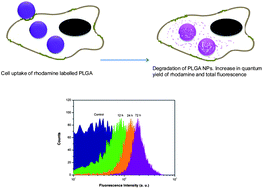A novel approach to monitor intracellular degradation kinetics of poly(lactide-co-glycolide) nanoparticles by means of flow cytometry†
Abstract
The intracellular degradation of poly(lactide-co-glycolide) (PLGA) nanoparticles (NPs) is studied by means of flow cytometry (FACS). NPs are prepared with PLGA of two different ratios of the D,L-lactide and glycolide blocks: 85 : 15 and 65 : 35. PLGA molecules are labelled with rhodamine B. Flow cytometry is first used to follow the degradation of PLGA NPs in PBS over time by measuring the decrease in fluorescence per particle. The 85 : 15 PLGA NPs progressively degrade during the first 10 days and remain constant thereafter. The 65 : 35 PLGA NPs remain unaltered, showing no changes in fluorescence intensity. FACS data are confirmed by transmission electron microscopy and dynamic light scattering measurements. Intracellular degradation of 85 : 15 PLGA is measured by the increase in fluorescence intensity in the cell population with time due to the liberation of rhodamine B labelled PLGA molecules from NPs in the cell interior where rhodamine displays an increased quantum yield. The fluorescence intensity from 85 : 15 PLGA NPs increases up to 24 hours, remaining constant thereafter. No change in the fluorescence of 65 : 35 PLGA NPs is observed after 4 days. The intracellular behaviour of the PLGA NPs is also confirmed by confocal Raman microscopy.


 Please wait while we load your content...
Please wait while we load your content...